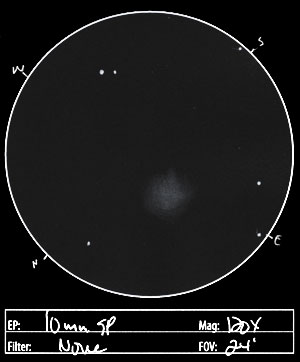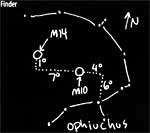
Observation Notes:
 This is a large, but unresolved cluster. I didn’t pick up any granularity. But hints of mottling suggest that I’m a couple inches of scope aperture shy of seeing some member stars. The core was not strong, and the outer halo faded softly to nothing. I believe I may have seen a soft spoke running off to the southwest, and some elongation to the core region running north-northwest to south-southeast.
This is a large, but unresolved cluster. I didn’t pick up any granularity. But hints of mottling suggest that I’m a couple inches of scope aperture shy of seeing some member stars. The core was not strong, and the outer halo faded softly to nothing. I believe I may have seen a soft spoke running off to the southwest, and some elongation to the core region running north-northwest to south-southeast.
Factoids:
M14 lies 30,000 light years away, although distance estimates range from 24,000 to 64,000. It is about 100 light years across, and is slightly elliptical, with a PA of 110°. The main body of the cluster is about 3′ in diameter, with a total apparent diameter of 11.7′. While it is dimmer than M10 and M12 from our point of view, it is also more distance and thus intrinsically brighter. Due to its great distance which results in faint stars, M14 is not well resolved in smaller telescopes. Under good conditions, a 4″ scope may make out graininess, with an 8″ scope showing some resolution and graininess.
M14 was discovered by Charles Messier in 1764 and first resolved into stars by William Herschel in 1783.
| Subject | M14 (NGC 6402) |
| Classification | Globular Cluster (Class VIII) |
| Position* | Ophiuchus [RA: 17:37:36 / Dec: -03:15:00] |
| Size* | 11.0′ |
| Brightness* | 7.6 |
| Date/Time | September 25, 2005 – 9:15 PM (September 26, 2005 – 04:15 UT) |
| Observing Loc. | Flagstaff, AZ – Home |
| Instrument | Orion SVP 6LT Reflector (150 mm dia./1200 mm F/L) |
| Eyepieces/Mag. | 10 mm (120X) |
| Conditions | Clear, calm, 60°F |
| Seeing | ~3-4/10 |
| Transparency | Mag 4.6 NELM (based on 20-Ophi) |
| Sources | SEDS |
*Based on published data.